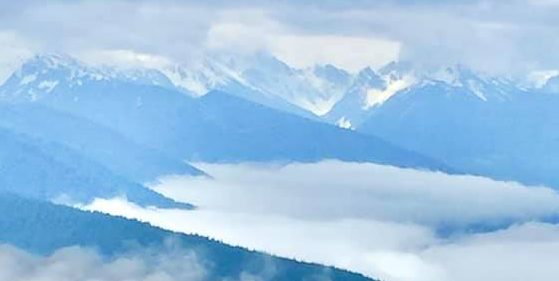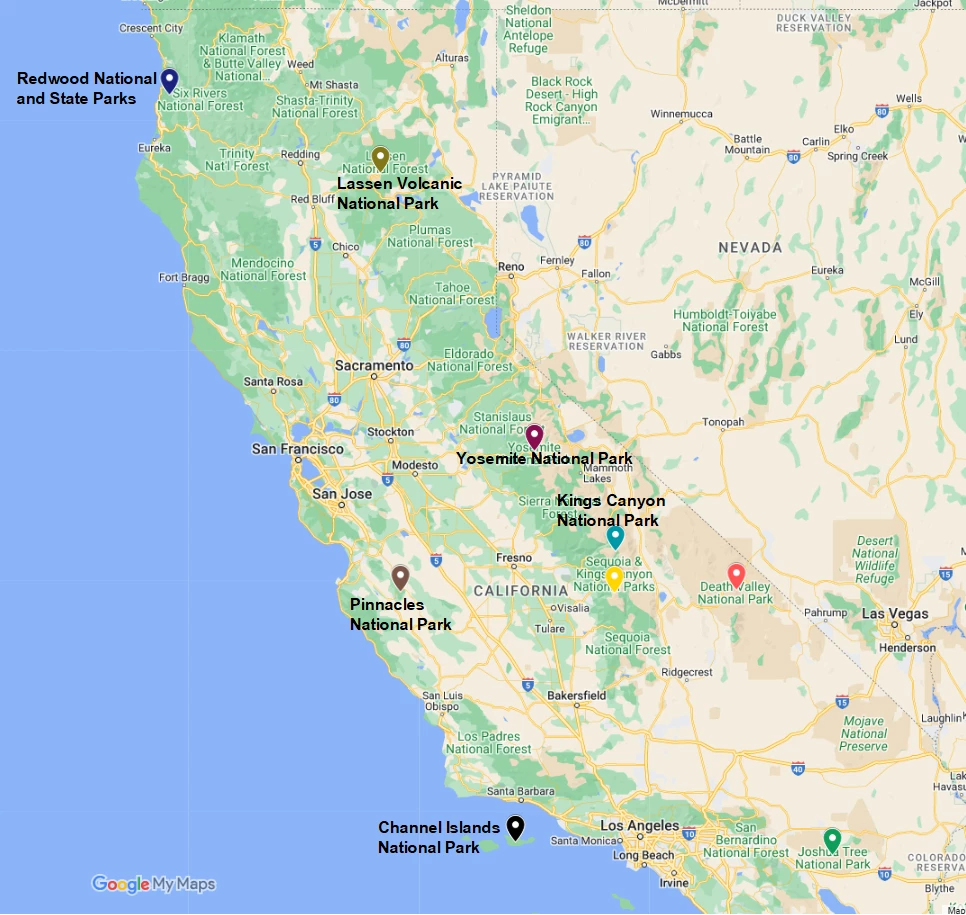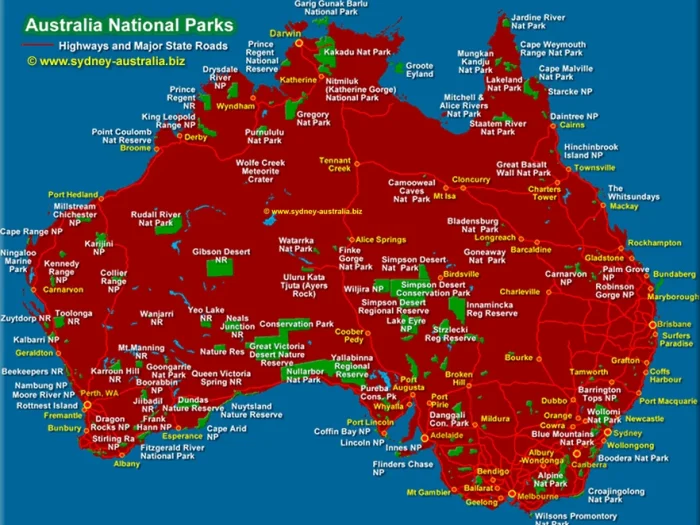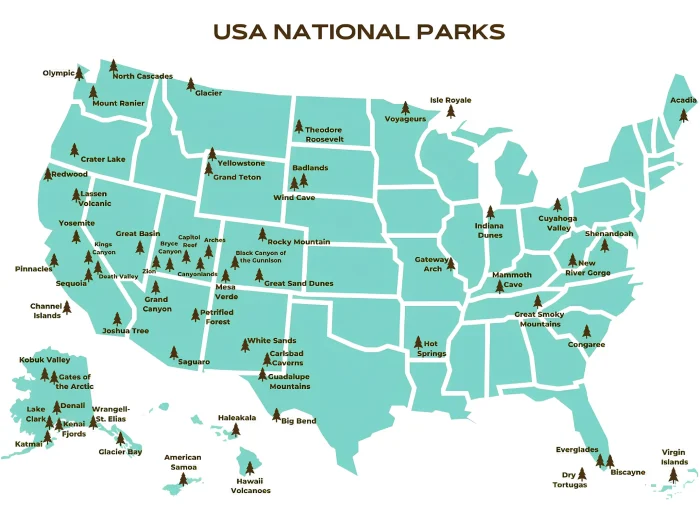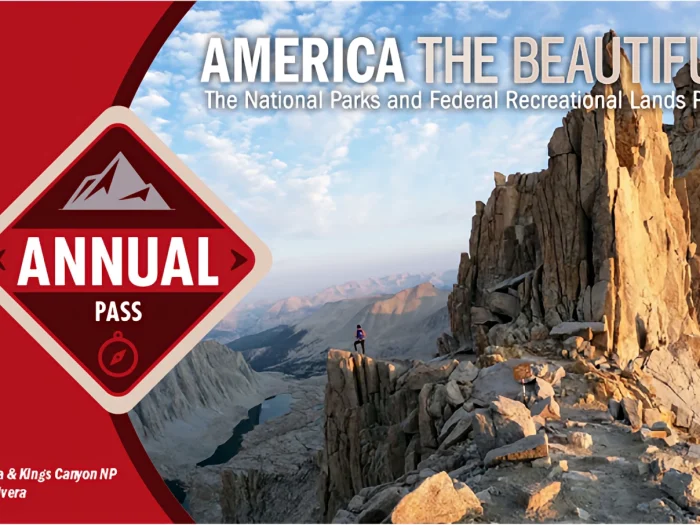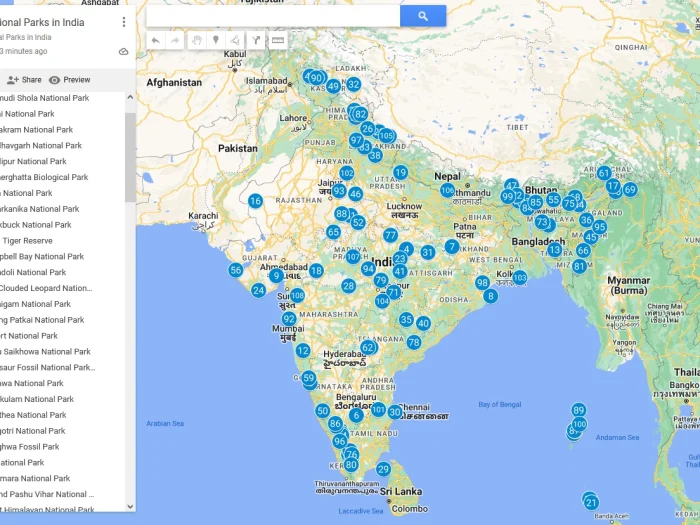National Parks in California
California has nine national parks, the most of any state, including famous destinations like Yosemite, Sequoia, Death Valley, Joshua Tree, and Redwood National Park. Other parks include Sequoia, Kings Canyon, Lassen Volcanic, Pinnacles, and the unique Channel Islands.
List of National Parks in California
- Channel Islands National Park
- Death Valley National Park
- Joshua Tree National Park
- Lassen Volcanic National Park
- Pinnacles National Park
- Redwood National Park
- Sequoia National Park
- Kings Canyon National Park
- Yosemite National Park
(You can click the image below to see California National Parks Map in full size)
List of national parks in California
1. Channel Islands National Park
The islands within the park extend along the southern California coast from Point Conception near Santa Barbara to just north of Los Angeles. Park headquarters and visitor center are located in the city of Ventura.
The Channel Islands, an island chain lying just off California’s southern coast, appear quite close on clear days. Five of the eight islands and their surrounding one nautical mile of ocean, with its kelp forests. comprise Channel Islands National Park.
Climate is mild, with little variation in temperature year round. However, be prepared for high winds, fog, and sea spray at any time. Visitors to the islands should dress in layers, with short and long pants, windbreaker, hat, sun screen, and waterproof outer clothing. Wear sturdy hiking shoes with non-slip soles.
2. Death Valley National Park
Death Valley National Park is located in southeastern California and also parts of it are in southwestern Nevada. It is between the Amargosa Desert in Nevada and the Inyo National Forest in California. The park is transected from east to west by California Highway 190. Death Valley is the largest national park in California.
Death Valley is generally sunny, dry, and clear throughout the year. The winters are mild with occasional winter storms, but summers are extremely hot and dry. Summer temperatures commonly run above 120 degrees fahrenheit. Comfortable sports wear providing sun protection and sturdy walking shoes are recommended in summer. Winter requires warmer clothing and light to medium jackets.
3. Joshua Tree National Park
Joshua Tree National Park is about 140 miles east of Los Angeles, near the resort and retirement region around Palm Springs. It is situated at the eastern end of Southern California’s Transverse mountain ranges. The eastern side of the park is bounded by the low lying Colorado Desert and the western side of the park is Mojave desert country.
Spring and Fall – Temperatures are most comfortable in the spring and fall, with an average of 85 F and low of 50 F.
Summer – Summers are hot, over–sometimes well over–100 F during the day and not cooling much below 75 F until the early hours of the morning.
Winter – Winter brings cooler days, around 60 F, and 32 F nights. In occasionally snows at higher elevations.
4. Kings Canyon National Park
Kings Canyon National Parks are located in west central California, west of Death Valley National Park and east of Fresno, California.
Kings Canyon National Park is the second-oldest national park in the United States. It was established on 25 Sep 1890 to protect the Big Trees in Giant Forest, including the General Sherman Tree, the world’s largest living thing. Sequoia also contains the Mineral King Valley and Mt. Whitney, the highest mountain in the U.S. outside of Alaska.
5. Lassen Volcanic National Park
Lassen Volcanic National Park is located about eight miles northeast of Mineral, CA, or fifty miles east of Red Bluff, CA on Highway 36 or 50 miles east of Redding, CA on Highway 44.
Snow covers much of the park mid October through early June. The Lassen Park Road (the main road that connects Highway 89) is usually closed late October through early June. Many of the main park attractions are snow covered and inaccessible by car and foot. July, August, and September may bring mostly sunny skies with warm daytime temperatures and cold nighttime temperatures.
6. Redwood National Park
Redwood National Park is located on the northwest Pacific coast of California, between the cities of Klamath Glen on the north and Trinidad on the south border or the park. The Park is situated along a long, narrow stretch of northern California coast, nearly abutting Oregon.
Summers are generally mild. Fog is often encountered near the coastline, with sunny, warmer weather more common inland. Winters are generally cool with considerable precipitation.
Wear layers of clothing to accommodate cool to warm temperatures and good walking shoes. Rain protection should be included at any time of year.
7. Pinnacles National Park
Pinnacles National Park is a U.S. national park located in central California, near the town of Soledad. It was designated as a national monument in 1908 by President Theodore Roosevelt and then became a national park in 2013. The park is known for its unique rock formations, including towering spires and talus caves.
When visiting Pinnacles National Park, it’s advisable to check for current trail conditions, as some areas may be closed seasonally or due to conservation efforts. The park offers a unique combination of geological features, outdoor recreation, and biodiversity, making it a popular destination for nature enthusiasts.
8. Sequoia National Park
Sequoia National Park are located in west central California, west of Death Valley National Park and east of Fresno, California.
Temperatures vary with elevation. In the summer, daytime temperatures often exceed 100° F in the foothills, but seldom exceed 90° F in the sequoia groves. Even in the summer, backpackers in the highcountry can encounter nighttime temperatures in the low 30’s, and occasionally even in the 20’s.
9. Yosemite National Park
Yosemite National Park is located in eastcentral California, east of the city of Modesto, California.
Yosemite National Park embraces almost 1,200 square miles of scenic wild lands set aside in 1890 to preserve a portion of the central Sierra Nevada that stretches along California’s eastern flank.
Weather can change rapidly during all seasons of the year. Elevation plays a major role in temperature and precipitation. Most of the moisture comes in the months of January, February and March, and the winter climate is relatively mild. Sierra summers are typically warm and dry. April and November are transitional months, when warm, sunny days can suddenly become stormy. Clouds can build up during the summer to produce spectacular thunderstorm activity.
California National Parks Map
Now you can answer the question:”how many national parks in california?” – California has total 9 national parks
Resources
Frequently Asked Questions
General Questions
- How many national parks are there in California?
California has nine national parks, more than any other U.S. state. - What are the names of the national parks in California?
Yosemite, Sequoia, Kings Canyon, Death Valley, Joshua Tree, Lassen Volcanic, Channel Islands, Pinnacles, and Redwood National Park. - Which is the most popular national park in California?
Yosemite National Park is the most visited, drawing millions of tourists annually. - Which is the largest national park in California?
Death Valley National Park — over 3.4 million acres of desert landscapes. - Which is the smallest national park in California?
Pinnacles National Park, with about 26,600 acres. - How old are California’s national parks?
Yosemite became a national park in 1890, making it one of the oldest in the U.S. - Who manages California’s national parks?
All parks are managed by the National Park Service (NPS) under the U.S. Department of the Interior. - What’s special about California’s national parks?
They feature diverse ecosystems—from deserts and beaches to forests, volcanoes, and mountains.
🏞️ Visiting & Access
- Do I need a pass or permit to enter national parks in California?
Yes, most parks require an entrance fee or a valid America the Beautiful pass. - Can I visit multiple parks with one pass?
Yes, the America the Beautiful Annual Pass grants access to all U.S. national parks. - When is the best time to visit California’s national parks?
Spring and fall offer mild weather and fewer crowds. - Are California’s national parks open year-round?
Most are open year-round, though some areas close in winter due to snow or weather conditions. - Do I need reservations to visit Yosemite National Park?
Sometimes. Peak seasons and holidays may require advance reservations. - How much does it cost to enter a national park in California?
Entrance fees range from $10–$35 per vehicle, depending on the park. - Are pets allowed in national parks?
Pets are allowed in certain areas, but not on most trails or in backcountry zones. - Are there guided tours available?
Yes. Many parks offer ranger-led programs, hikes, and educational tours. - Can I drive through all of California’s national parks?
Some can be accessed by car (like Yosemite or Joshua Tree), while others (like Channel Islands) require a boat or plane. - Do California national parks have visitor centers?
Yes, each park has at least one visitor center with maps, exhibits, and ranger information. - Are California’s national parks accessible for people with disabilities?
Most have ADA-compliant facilities, accessible trails, and programs. - Do I need to book campsites in advance?
Yes. Campsites fill quickly, especially in Yosemite, Joshua Tree, and Sequoia.
🏕️ Activities & Experiences
- What are the top things to do in California’s national parks?
Hiking, camping, photography, rock climbing, stargazing, and wildlife watching. - Which parks are best for camping?
Yosemite, Joshua Tree, Sequoia, and Lassen Volcanic have excellent camping areas. - Can I hike in all national parks?
Yes. Each park has designated hiking trails for all skill levels. - Which national park is best for stargazing?
Death Valley is an International Dark Sky Park, known for crystal-clear night skies. - Which park is best for seeing giant trees?
Sequoia and Redwood National Parks feature the world’s tallest and largest trees. - Are there hot springs in California’s national parks?
Yes. Lassen Volcanic National Park has geothermal areas and bubbling springs (not for bathing). - Can I fish in national parks?
Fishing is allowed in some parks with a California fishing license. - Can I swim or kayak in national parks?
Yes, especially in Channel Islands and Lassen Volcanic National Parks. - Are drones allowed in national parks?
No. The use of drones is prohibited in all U.S. national parks. - Are there biking trails in California’s national parks?
Yes, but biking is limited to paved and designated roads/trails.
🌋 Nature & Wildlife
- What types of wildlife live in California’s national parks?
Animals include black bears, mule deer, mountain lions, sea lions, and hundreds of bird species. - Are there volcanoes in California’s national parks?
Yes, Lassen Volcanic National Park is home to active geothermal areas and volcanic peaks. - Are there deserts among California’s national parks?
Yes. Death Valley and Joshua Tree are both desert parks. - Can I see wildflowers in the parks?
Yes. Spring brings vibrant wildflower blooms, especially in Joshua Tree and Death Valley. - Are there endangered species in these parks?
Yes. Parks protect endangered species like the California condor and desert tortoise. - How do California’s parks support conservation?
Through habitat restoration, wildlife monitoring, and sustainable tourism programs. - Are there waterfalls in California’s national parks?
Yes. Yosemite Falls is one of the tallest waterfalls in North America. - Can you see snow in California’s national parks?
Yes, during winter months in Yosemite, Sequoia, Kings Canyon, and Lassen Volcanic.
🚗 Logistics & Tips
- How can I reach Channel Islands National Park?
Only by boat or small aircraft from Ventura or Oxnard—there are no roads or bridges. - What should I pack for a trip to California’s national parks?
Essentials include water, sun protection, layered clothing, sturdy shoes, maps, and a first aid kit.
Read more:
